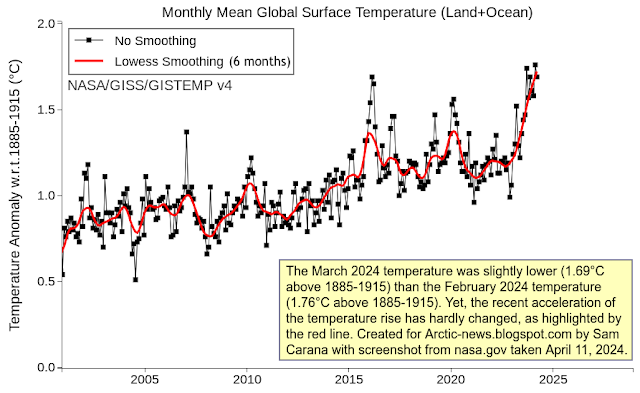The astonishing recent rise in temperatures makes one wonder whether a Regime Change did take place in 2023.
The February 2024 temperature was 1.76°C above 1885-1915, potentially 2.75°C above pre-industrial (bright yellow inset right). The image was created by Sam Carana for Arctic-news.blogspot.com with an April 2024 data.giss.nasa.gov screenshot. The red line (6 months Lowess smoothing) highlights the Regime Change that may have occurred in 2023.
Meanwhile, NASA has released details for the March 2024 temperature, which was slightly lower (1.69°C above 1885-1915) than the February 2024 temperature (1.76°C above 1885-1915). Yet, the recent acceleration of the temperature rise has hardly changed, as highlighted by the red line. The question is whether this red line will continue with this steep rise.
The image below, created with NASA Land+Ocean monthly mean global temperature anomalies versus a 1900-1923 custom base, further adjusted by 0.99°C to reflect ocean air temperatures, higher polar anomalies and a pre-industrial base.
 |
| [ from earlier post ] |
The above image shows a magenta trend that points at the temperature crossing 3°C above pre-industrial later this year (2024).
What could have caused such a steep rise? Of course, short-term variables such as El Niño did have a strong impact. However, sea surface temperatures have risen hugely for more than a year, far exceeding the temperatures of 2016, which was a strong El Niño year. This indicates that there must be other factors involved in the recent rise.
The image below shows world daily sea surface temperatures (60°S-60°N) through April 8, 2024.
For more than a year, sea surface temperatures have been much higher than in any previous year on record, as if temperatures suddenly shifted into another gear and the climate experienced a Regime Change in 2023.
 |
| [ from the Extinction page ] |
The top image illustrates that the temperature rise since pre-industrial could be as large as 2.75°C, as also discussed at the pre-industrial page. The extinction page points out that such a rise corresponds with almost ⅕ more water vapor in the atmosphere.
This increase in water vapor in the atmosphere is a self-reinforcing feedback, since water vapor is a powerful greenhouse gas, accelerating the temperature rise (as illustrated by the image on the right).
There is no single feedback behind the recent steep rise, instead there are numerous non-linear, self-reinforcing feedbacks that can all contribute, interact and start to kick in with greater ferocity, amplifying and accelerating the rise.
Such feedbacks include water vapor, storms, ocean stratification, loss of sea ice, loss of reflectivity of clouds and freshwater accumulating at the surface of oceans, due to stronger ice melting, due to heavier runoff from land and rivers and due to changes in wind patterns and ocean currents and circulation. Furthermore, developments such as the reduction in sulfur emissions from shipping over the past few years further push up the temperature rise.
Altogether, the temperature rise may exceed 18°C from pre-industrial by as early as 2026, as discussed at the Extinction page.
Climate Emergency Declaration
The situation is dire and the precautionary principle calls for rapid, comprehensive and effective action to reduce the damage and to improve the situation, as described in this 2022 post, where needed in combination with a Climate Emergency Declaration, as discussed at this group.
Links
• NASA – datasets and images
https://data.giss.nasa.gov
• Climate Reanalyzer
https://climatereanalyzer.org
• Pre-industrial
https://arctic-news.blogspot.com/p/pre-industrial.html
• Extinction
https://arctic-news.blogspot.com/p/extinction.html
• Jet Stream
https://arctic-news.blogspot.com/p/jet-stream.html
https://arctic-news.blogspot.com/p/cold-freshwater-lid-on-north-atlantic.html
• Arctic Ocean Feedbacks
• Arctic sea ice set for steep decline
• Transforming Society
https://arctic-news.blogspot.com/2022/10/transforming-society.html
• Climate Plan
https://arctic-news.blogspot.com/p/climateplan.html
• Climate Emergency Declaration
https://arctic-news.blogspot.com/p/climate-emergency-declaration.html




